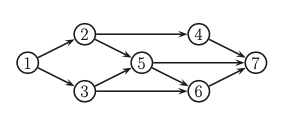Conditional independence¶
The most important part of graphical models is the conditional independence assumption.
Hence A is independent of B given C in the graph G and is defined as:
Let \(I(G)\) be a set of all such CI statements encoded by the graph. We say that \(G\) is an I-map (Independence map) for \(p\), or that \(p\) is Markov wrt \(G\), iff \(I(G) \subseteq I(p)\) where \(I(p)\) is the set of all CI statements that hold for distribution \(p\), in other words, the graph is an I-map if it does not make any assertions of CI that are not true of the distribution. This allows a graph to model CI.
In case that a graph is fully connected, it is an I-map of all distributions since it does not make any CI assumptions. Hence we can say that \(G\) is a minimal I-map of \(p\) if \(G\) is an I-map of \(p\), and if there is no \(G' \subseteq G\) which is an I-map of p.
D-Separation¶
Allows to reason about CI in graphs. From this we can derive other rules:
Clarify some notation
\(\{1,2,3\} \backslash \{1,3\} = \{2\}\)$
Directed local Markov property¶
nd(t) are the non descendants of a node (\(nd(t) = V \space \backslash \space \{ t \cup desc(t) \}\))
This equation is also known as the directed local Markov property.
Example:
\(nd(3) = \{2,4 \}\) and \(pa(3) = 1\) hence \(3 \perp 2,4 | 1\)
Ordered markov property¶
\(pred(3) = \{1,2 \}\) and \(pa(3) = 1\) then \(3 \perp 2 | 1\)
Markov blanket and full conditionals¶
Markov blanket \(mb(t)\) of a node t is the set of of nodes that renders the node t conditionally indpendent of the other nodes in the graph.
Markov blanked of a node in a DGM is equal to the parents, children and co-parents (nodes who are also parents of its children)
\(mb(5) = \{ 6,7\} \cup \{ 2,3\} \cup \{4\}\)
To see why the co-parents are in the Markov blanked we can derive
All the terms that od not involve \(x_t\) will cancel out between numerator and denominator, so we are left with a product of CPDs which contain \(x_t\) in their scope:
Example:
\(p(x_5 | x_{-5}) \propto p(x_5| x_2, x_3)p(x_6|x_3,x_5)p(x_7|x_4, x_5,x_6)\)
This result is called t’s full conditional distribution

